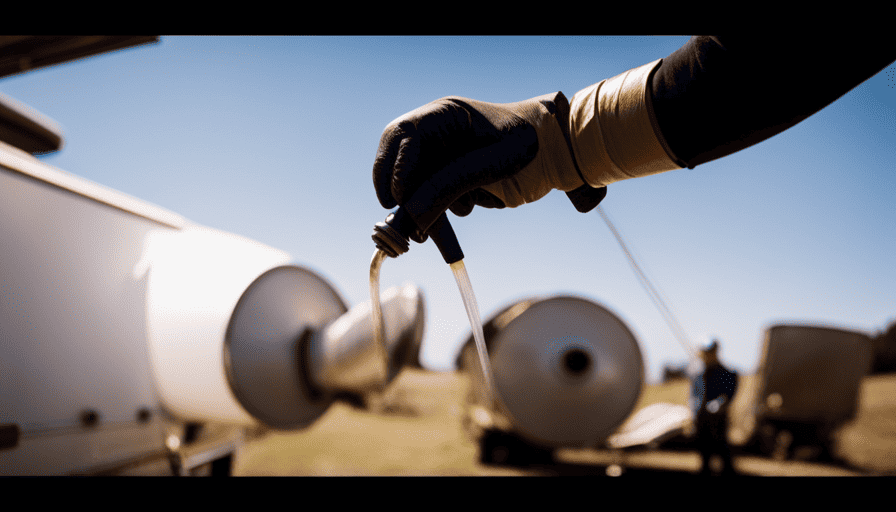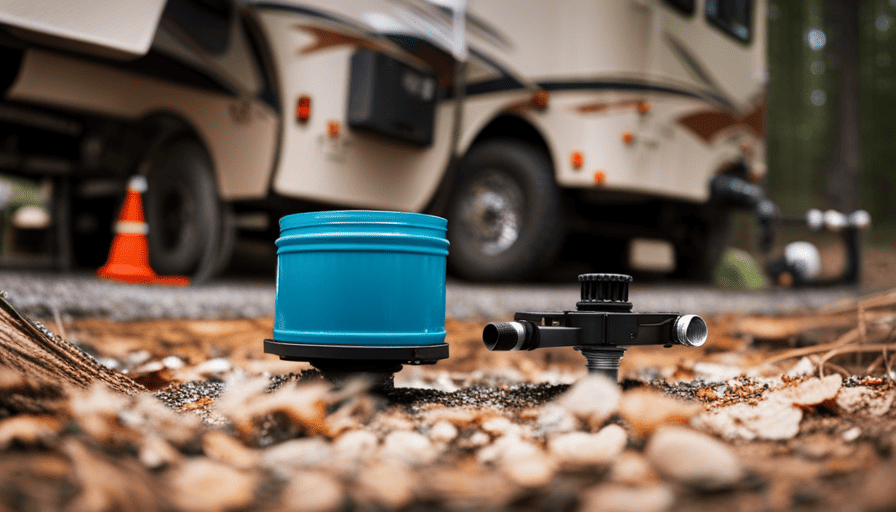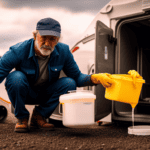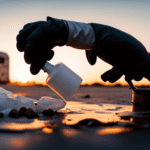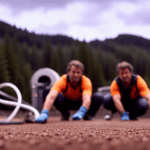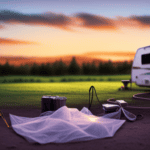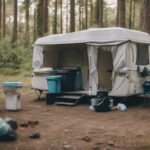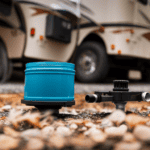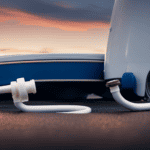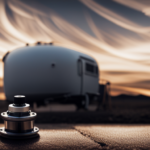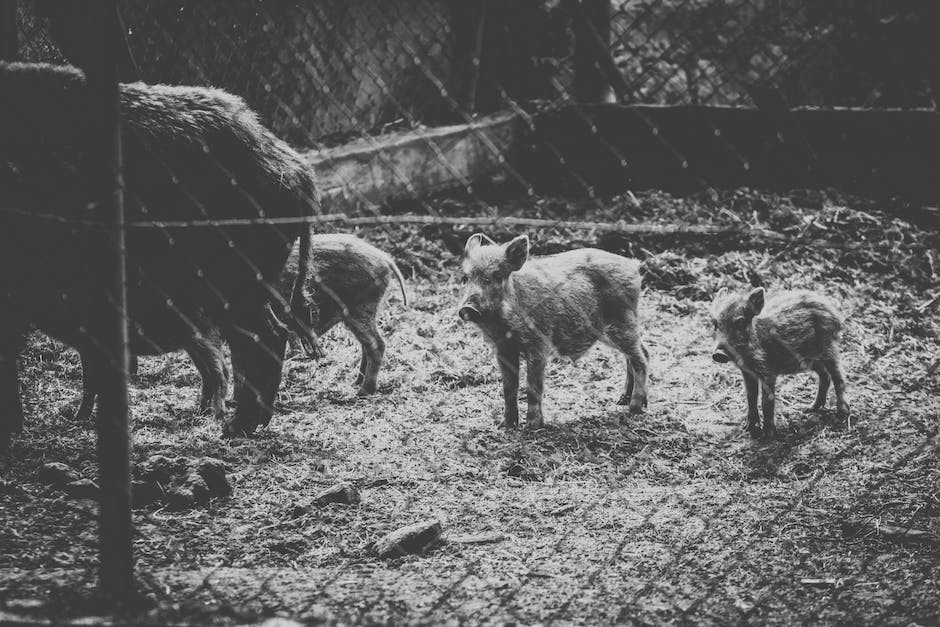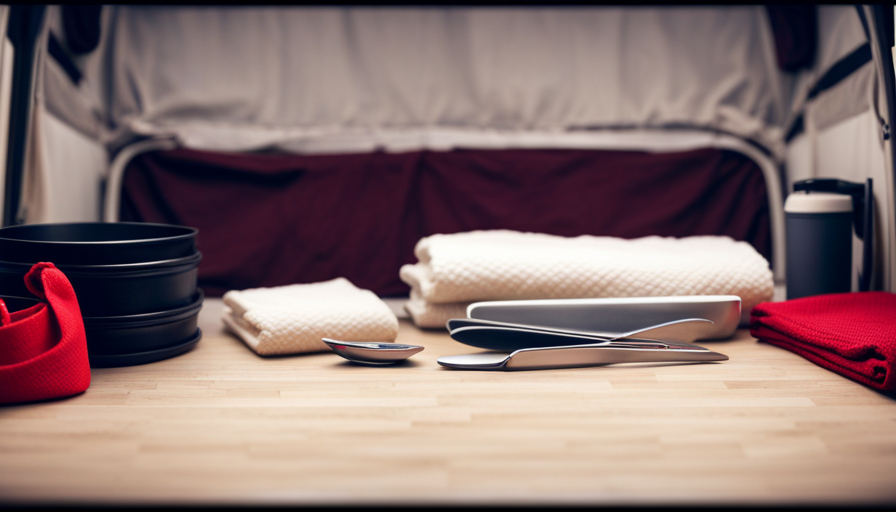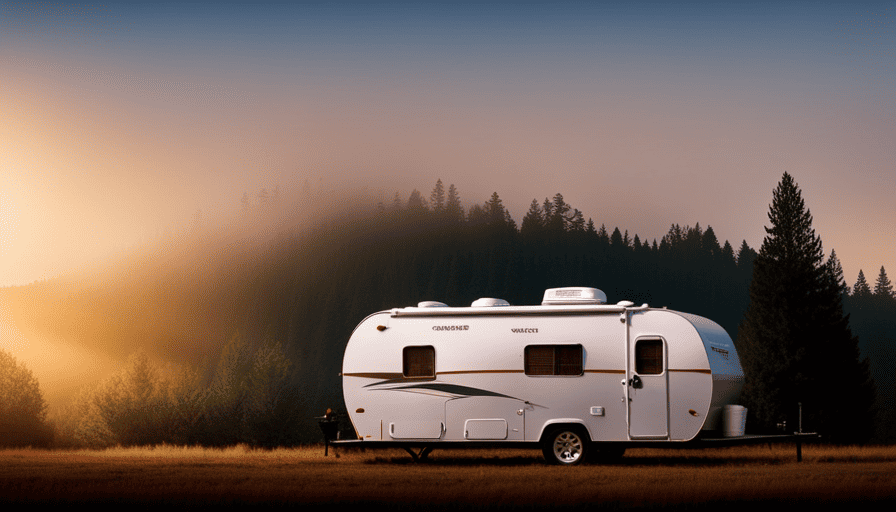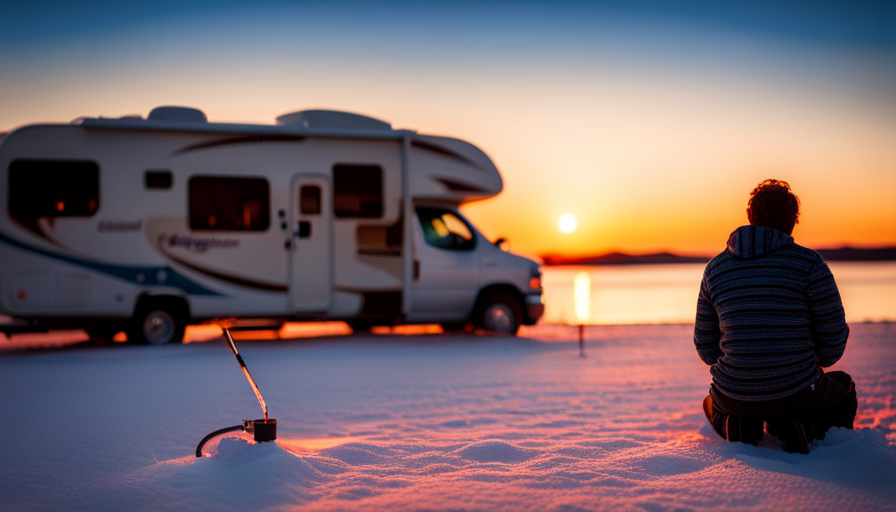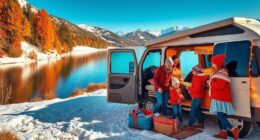Imagine this scenario: you’re embarking on an amazing journey, venturing through the wilderness in your reliable camper. The weather is perfect, the birds are chirping, and your joy knows no bounds. Suddenly, you’re reminded of the less appealing aspects of the adventure when it’s time to deal with the unpleasant duty of clearing out the waste from your camper’s black water tank.
Don’t worry, I’ve got you covered.
In this comprehensive guide, I’ll walk you through the step-by-step process of properly emptying your camper’s waste tank. From gathering the necessary equipment to finding a designated dumping station, I’ll leave no stone unturned. I’ll also share tips for maintaining good hygiene, preventing odors and clogs, and even explore alternative waste disposal options.
Whether you’re a seasoned camper or a newbie hitting the road for the first time, this article is your go-to resource for all things poop-emptying related.
So, let’s dive in and ensure that your next camping adventure remains pleasant and odor-free.
Key Takeaways
- Properly emptying the camper’s waste tank is essential for a clean and odor-free camping experience.
- Following local regulations and finding designated dumping stations or campsites for waste disposal is important to prevent environmental pollution and avoid fines.
- Wearing protective gear such as disposable gloves and practicing good hygiene, including thorough handwashing, is crucial when handling waste to prevent exposure to harmful bacteria.
- Regular tank maintenance, including using tank treatments and monitoring tank levels, is necessary to prevent leaks, control odors, and ensure a hygienic camping experience.
Gather the necessary equipment
Now that you’re ready to empty the poop from your camper, let’s start by gathering all the necessary equipment you’ll need.
When it comes to camper equipment for waste disposal, there are a few essential items you shouldn’t forget. The first thing you’ll need is a pair of disposable gloves to protect your hands from any potential mess. Additionally, a sewer hose is crucial for connecting your camper’s waste tank to the dumping station. Make sure the hose is long enough to reach the station comfortably.
You’ll also need a sewer hose support, which keeps the hose elevated and prevents any unwanted leaks or spills. A clear elbow adapter is another useful tool to have, as it allows you to see when the waste has finished emptying. Lastly, don’t forget to bring disinfectant wipes or spray to clean up afterward.
Now that you have all the necessary equipment, let’s move on to finding a designated dumping station, where you can safely dispose of the waste without causing any harm to the environment or public health.
Find a designated dumping station
To properly dispose of waste, locate a designated dumping station for your camper’s contents. It’s essential to find a designated dumping station to ensure the proper disposal of waste from your camper.
These stations are specifically designed to handle and treat the waste in a safe and environmentally friendly manner. In some areas, it may be illegal to empty your camper’s waste anywhere other than a designated dumping station.
Finding a designated dumping station is relatively easy. Many campgrounds and RV parks have their own dumping stations available for guests to use. You can also use online resources or mobile apps that provide information about nearby dumping stations. These resources often include user reviews and ratings, which can help you find the most suitable station for your needs.
It’s important to note that finding alternative methods for emptying your camper’s waste, such as dumping it in unauthorized locations or down storm drains, isn’t just illegal but also poses potential health risks. Improper disposal of waste can contaminate water sources and spread harmful bacteria and diseases. So, it’s crucial to use designated dumping stations for the safety of both the environment and public health.
Now that you’ve located a designated dumping station, it’s time to prepare your camper for emptying without causing any mess or inconvenience.
Prepare the camper for emptying
Ensure that your camper is properly prepared for waste disposal to avoid any potential mess or inconvenience.
Camper sanitation and waste management are essential aspects of emptying poop from a camper. Before emptying the black water tank, it’s crucial to follow a few steps to ensure a smooth and clean process.
First, gather all the necessary equipment for waste disposal, such as gloves, a hose, and a sewer hose support. These items will help prevent any contact with waste and ensure a more sanitary process.
Next, make sure to close all the valves and secure all the connections to prevent any leaks or spills. It’s also important to double-check that the black water tank isn’t overfilled to avoid any overflow.
Once you’ve prepared the camper, you can proceed to empty the black water tank. This process involves connecting the sewer hose to the camper’s waste outlet and then to the designated dumping station.
By following these steps, you can efficiently and hygienically empty the black water tank without any hassle or mess.
Empty the black water tank
Make sure you don’t neglect the crucial task of properly disposing of the waste in your black water tank, as it’ll ensure a clean and hassle-free camping experience.
To empty the black water tank in your camper, follow these proper disposal techniques:
-
Find a designated dump station: Look for RV parks, campgrounds, or rest areas that provide dump stations specifically designed for emptying black water tanks. These stations have the necessary equipment to safely dispose of waste.
-
Use protective gear: Health hazards may be present when dealing with waste, so it’s important to wear gloves and other protective gear to minimize the risk of contamination and ensure your safety.
-
Follow safety precautions: Before emptying the tank, make sure to turn off any appliances that use propane or have open flames. Additionally, be cautious of any nearby sources of ignition. These precautions are essential to prevent accidents and potential explosions.
Proper disposal techniques and safety precautions are crucial when emptying your black water tank.
Now, let’s discuss how to rinse and clean the tank for optimal hygiene and functionality.
Rinse and clean the tank
To properly rinse and clean the black water tank in my camper, I use a tank cleaning solution specifically designed for this purpose. This solution effectively breaks down any remaining waste and helps eliminate odors.
After adding the solution to the tank, I ensure a thorough rinse by flushing water through the tank multiple times until it runs clear. This process ensures that the tank is clean and ready for future use.
Use a tank cleaning solution
First, mix a tank cleaning solution with water to effectively clean out the camper’s waste tank, improving its overall hygiene and preventing any unpleasant odors.
Did you know that using a tank cleaning solution can help eliminate up to 99% of bacteria and germs from the waste tank? It’s important to use a tank cleaning solution specifically designed for RV waste tanks, as regular household cleaners may not be effective. These specialized solutions contain enzymes and bacteria that break down waste and neutralize odors.
To use the tank cleaning solution, simply follow the instructions on the product packaging and add the appropriate amount to the tank with water. Allow the solution to sit for the recommended time to let it work its magic.
Once the solution has done its job, you can proceed to thoroughly rinse the tank, removing any remaining residue and ensuring a clean and odor-free waste tank.
Thoroughly rinse the tank
Once the tank cleaning solution has effectively neutralized odors and eliminated bacteria, it’s crucial to thoroughly rinse the waste tank to ensure a completely clean and fresh environment. Thoroughly rinsing the tank is an important step in the cleaning process as it helps to remove any remaining residue or debris.
To do this, start by filling the tank with clean water and then emptying it completely. Repeat this process multiple times to ensure that all traces of waste and cleaning solution are thoroughly flushed out. Pay special attention to the corners and nooks of the tank, as these areas can often harbor buildup.
Finally, inspect the tank to ensure that it’s completely clean and free of any debris. With a properly rinsed tank, you can move on to the next step of disposing of waste properly.
Dispose of waste properly
When it comes to disposing of waste from a camper, it’s crucial to follow local regulations to ensure that we’re doing it properly. This may include finding designated dumping stations or campsites that provide waste disposal facilities. By adhering to these regulations, we can avoid polluting the environment and ensure that our waste is disposed of in a safe and responsible manner.
It’s our responsibility as campers to be knowledgeable, thorough, and detailed in our approach to waste disposal. This is in order to protect the natural beauty of our surroundings.
Follow local regulations
While exploring the great outdoors in your camper, it’s essential to abide by local regulations when it comes to emptying poop. Following regulations not only ensures that you stay on the right side of the law but also minimizes the environmental impact of waste disposal.
To truly understand the importance of this, consider the following:
-
Violating regulations can result in hefty fines, ruining your outdoor experience and leaving a dent in your wallet.
-
Improper disposal can contaminate water sources, harming aquatic life and making them unsuitable for recreational activities.
-
Neglecting to follow regulations can contribute to the spread of harmful pathogens, posing a risk to both humans and wildlife.
By adhering to local regulations, we can protect the environment and preserve the beauty of our natural surroundings.
Now, let’s discuss how to avoid polluting the environment when emptying poop from your camper.
Avoid polluting the environment
To prevent environmental pollution, make sure you dispose of waste properly while enjoying the great outdoors in your camper. It’s important to reduce pollution and choose eco-friendly options when it comes to emptying your camper’s poop.
First, consider using biodegradable toilet paper to minimize the impact on the environment. Additionally, use designated dump stations to empty your waste tanks instead of dumping them in nature. These dump stations are equipped with proper disposal systems that treat the waste appropriately. Moreover, some campgrounds offer composting toilets or sewer hookups, which are more environmentally friendly options. By utilizing these options, you can ensure that you’re not polluting the environment while enjoying your camping experience.
Transitioning into the next section about practicing good hygiene, it’s crucial to maintain cleanliness and prevent the spread of harmful bacteria.
Practice good hygiene
When practicing good hygiene while emptying waste from a camper, it’s important to wear gloves and protective clothing to prevent any direct contact with the waste. This will help minimize the risk of exposure to harmful bacteria and potential infections.
After emptying the waste, it’s crucial to thoroughly wash your hands with soap and water for at least 20 seconds to further reduce any potential contamination.
Wear gloves and protective clothing
Before you start, make sure you’re suited up in gloves and protective clothing to handle the task of emptying poop from your camper. It’s essential to protect yourself from any potential contamination or exposure to harmful bacteria.
Wearing protective gear such as gloves and clothing will create a barrier between you and the waste, minimizing the risk of infection. Additionally, it’s crucial to know and follow proper disposal methods. This includes using designated waste disposal areas or facilities and avoiding dumping waste in inappropriate locations.
By adhering to these guidelines, you can ensure the safe and responsible disposal of waste from your camper. Once the task is complete, remember to wash your hands thoroughly to further minimize any potential contamination. This will help maintain good hygiene and prevent the spread of harmful bacteria.
Wash hands thoroughly after emptying
After completing the task, it’s crucial to thoroughly wash your hands to ensure the utmost cleanliness and prevent the spread of any potential harmful bacteria. Hand hygiene is of utmost importance when dealing with waste disposal. Proper sanitation is key to maintaining good health and preventing the transmission of diseases.
Start by using warm water and soap, making sure to lather your hands for at least 20 seconds, paying attention to all areas including between your fingers and under your nails. Rinse well and dry with a clean towel or air dry.
Remember to also clean any surfaces that may have come into contact with waste, using appropriate disinfectants. By following these steps, you can maintain a high level of cleanliness and prevent any potential health risks.
Moving on to the subsequent section about maintaining regular tank maintenance, it’s important to…
Maintain regular tank maintenance
I always make sure to maintain regular tank maintenance for my camper to ensure a pleasant and odor-free experience. One key point is to use tank treatments to control odors, which help break down waste and eliminate any unpleasant smells.
Additionally, I regularly monitor the tank levels and make sure to empty it when necessary to prevent any overflow or backup. By following these simple steps, I can ensure a clean and comfortable camping experience every time.
Use tank treatments to control odors
To keep your camper smelling fresh and pleasant, make sure to use tank treatments regularly to control odors. Tank treatments are specially formulated chemicals that help break down waste and control odor in your camper’s holding tanks. These treatments come in various forms such as liquids, powders, or drop-in packets, and they work by introducing beneficial bacteria into the tanks that help break down waste and eliminate odors. It is important to follow the instructions on the packaging when using tank treatments to ensure proper dosage and effectiveness. Using tank treatments regularly, along with proper tank maintenance, will help keep your camper smelling clean and odor-free. Additionally, monitoring tank levels and emptying when necessary is crucial to prevent overfilling and potential leaks.
Monitor tank levels and empty when necessary
Keep an eye on your tank levels and make sure to empty them when they get full to avoid any potential leaks or spills. Monitoring tank levels is crucial in maintaining a clean and odor-free camper. Most campers have a built-in monitoring system that indicates the level of waste in the tanks. Check this regularly to ensure you know when it’s time to empty.
When the tanks are full, it’s important to follow proper waste disposal procedures. Locate a designated RV dump station or campground facility that allows waste disposal. Follow all guidelines and regulations for emptying your tanks safely and cleanly.
By monitoring tank levels and practicing proper waste disposal, you can maintain a hygienic and pleasant camping experience.
Now, let’s consider alternative waste disposal options.
Consider alternative waste disposal options
Consider exploring alternative waste disposal options to rid your camper of its unsavory cargo. It’s like embarking on a quest for a hidden treasure, finding a sustainable and eco-friendly method that’ll relieve you from the burden of dealing with poop.
As an avid camper myself, I’ve discovered three alternative waste management options that are worth considering.
-
Composting Toilets: These toilets use natural processes to break down waste into compost. They’re odorless, require little to no water, and can be installed in your camper. Composting toilets are a great option for those looking to minimize their environmental impact while on the road.
-
Bio-Digesters: These systems use bacteria to break down waste into harmless byproducts, such as methane gas and fertilizer. Bio-digesters are compact and can be installed in your camper, providing a convenient and eco-friendly waste disposal solution.
-
Portable Waste Disposal Systems: These systems are compact and easy to use. They typically consist of a portable tank that can be emptied at designated waste disposal sites. While not as environmentally friendly as composting toilets or bio-digesters, portable waste disposal systems offer a practical solution for campers who prefer a more traditional waste disposal method.
By exploring these alternative waste disposal options, you can find a method that suits your needs and values.
Now, let’s move on to some tips for preventing odors and clogs to ensure a pleasant camping experience.
Tips for preventing odors and clogs
Implementing proper practices for waste management can help you thwart foul smells and frustrating blockages during your camping escapades.
When it comes to preventing odors and clogs in your camper’s waste system, there are a few tips that can make a big difference.
First and foremost, it’s crucial to prevent leaks in your camper’s waste system. One way to do this is by regularly checking all connections and seals for any signs of damage or wear. If you notice any leaks, be sure to repair them immediately to avoid unpleasant odors and potential messes.
Another important aspect of preventing odors and clogs is choosing the right cleaning products. It’s advisable to use eco-friendly and biodegradable products specifically designed for RV waste systems. These products are not only effective in cleaning and deodorizing, but they also help maintain the integrity of your camper’s waste system.
Additionally, it’s crucial to follow proper waste disposal guidelines. Avoid flushing anything other than human waste and toilet paper down the toilet. Items such as feminine hygiene products, wipes, or paper towels can easily cause clogs and should be disposed of in designated trash receptacles.
By implementing these tips for preventing odors and clogs, you can ensure a more pleasant and hassle-free camping experience. Remember to regularly inspect your waste system for leaks, choose the right cleaning products, and follow proper waste disposal practices. Happy camping!
Frequently Asked Questions
What should I do if I can’t find a designated dumping station nearby?
If I can’t find a designated dumping station nearby, there are alternative waste disposal methods that I can use. One option is to dig a cathole at least 200 feet away from any water sources and bury the waste.
Another method is to use a portable waste disposal system, such as a portable toilet or a waste containment bag.
It’s important to properly dispose of waste in the wilderness to minimize environmental impact and maintain cleanliness.
Can I empty the black water tank into a regular toilet?
Yes, it is possible to empty the black water tank into a regular toilet, but it may not be the best solution. Black water contains waste and chemicals that can be harmful to septic systems and plumbing. It’s recommended to use designated dumping stations whenever possible. If a dumping station isn’t available, alternative disposal methods like portable waste tanks or composting toilets can be used. These options ensure proper disposal without risking damage to plumbing or the environment.
How often should I clean and rinse the black water tank?
Cleaning and regularly maintaining your black water tank is vital for the proper functioning and longevity of your camper. Many people wonder how often they should clean and rinse their tank. Well, let me assure you, regular maintenance is key.
By cleaning and rinsing your black water tank every 3-4 uses, you can prevent the buildup of waste and odors, ensuring a clean and hassle-free camping experience.
Are there any specific products or methods I can use to prevent odors and clogs in the tank?
To prevent odors and clogs in your camper’s black water tank, there are a few products and methods you can use. Firstly, I recommend using a specialized RV toilet paper that dissolves quickly and doesn’t cause blockages.
Additionally, adding a tank treatment solution regularly can help break down waste and control odors.
Lastly, make sure to properly maintain and clean the tank to prevent any buildup. These steps will ensure a clean and odor-free camping experience.
What are some alternative waste disposal options for campers without access to dumping stations?
When it comes to waste disposal options for campers without access to dumping stations, there are two great alternatives: composting toilets and portable waste disposal bags.
Composting toilets are self-contained units that break down waste into compost, eliminating the need for a dumping station.
Portable waste disposal bags, on the other hand, are specially designed for easy and hygienic waste disposal. They can be sealed and disposed of in regular trash bins, making them convenient for campers on the go.
Are the Steps to Empty Camper Sewage the Same as Emptying Poop from the Camper?
Emptying camper sewage is a necessary task for RV owners, but is it the same as emptying poop from the camper? While the overall goal is to dispose of waste, the steps may differ. Emptying camper sewage typically involves connecting a hose to a dumping station, releasing the sewage, and rinsing the tank. On the other hand, emptying poop may involve removing waste from a portable toilet or designated container.
Conclusion
In conclusion, emptying the poop from a camper is an essential task that requires proper equipment, preparation, and maintenance. By following the steps outlined in this article, you can ensure a clean and odor-free camper experience.
Remember to practice good hygiene and regularly maintain your tank to prevent any issues. Interestingly, according to a study by RVtravel.com, 80% of RVers reported that they experienced odor problems due to improper waste disposal. This statistic highlights the importance of following the correct procedures to avoid unpleasant odors and keep your camper in top shape.

